If you are here, odds are that you are looking for a complete guide to Parmigiano Reggiano! It may be because you are a bit confused about what Parmigiano Reggiano is, why it is different (or not) from Parmesan, how this incredible cheese is made or because you have so many questions about it. Including: is Parmesan and Parmigiano Reggiano the same? (I spoiler this with pleasure: no 🙂 ).
I decided to create this post to give you the point of view on the “King of cheese” from the perspective of a food lover born in the area where Parmigiano Reggiano is from. Because yes, first of all, it’s important to know that Parmigiano Reggiano is made in an area that includes three whole city territories (Parma, Reggio Emilia, Modena), the part of Mantova on the right side of the Po river and the part of Bologna on the left of the Reno river. The name comes from the first two cities included in this area, and the two most widely involved in the making of this cheese.
If you will find this post useful, just PIN IT! 🙂
And if you want a recommendation from a person coming from Parmigiano Reggiano territory… outside of Italy this is the best option I found for you!
How is Parmigiano Reggiano made?
Last year, before the covid pandemic, I had the chance to visit one dairy near Parma, precisely San Pier Damiani dairy, near Parma. There is where I took the pictures and the videos I share here with you.
Half-day spent in that amazing place made me understand even more how incredible Parmigiano Reggiano is and how much the love they put into this cheese is important in the final result. So… sit down and let this journey begin!
Step 1 – It all starts with good quality milk and rennet
The King of cheese is the result of only three ingredients: cow milk, salt (see below, in the brining section) and rennet. The rules about the milk are very strict: cows must be fed on locally grown forage, and the list of bans is quite long: no silage, no fermented feeds nor animal flour allowed. Every day, early in the morning, a cheesemaker (casaro in Italian) combines whole milk with naturally skimmed milk from the evening before. (Note: the skimmed cream will be used for the production of butter, which is always a side product of Parmigiano Reggiano production). Consider that each wheel of cheese requires about 550 liters of milk. Since each of the huge copper-lined vats you see will give birth to two wheels, in each of them the cheesemaker is working 1,100 liters of milk! The cheesemaker brings the temperature to 33 °C, and then adds bacteria in the form of rennet, he (or she) will make the milk mixture curdle briefly.
Step 2 – Curdling
They then break up the resulting curd into smaller pieces, using that long tool named spino in Italian …
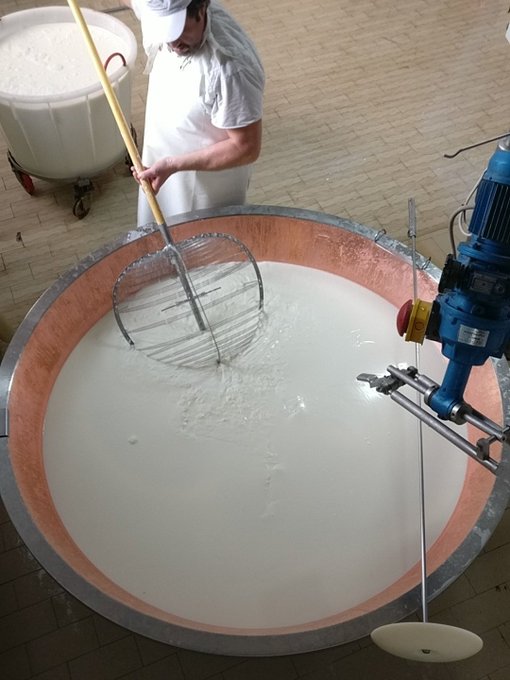
… and cook it carefully for about an hour at the temperature of 55 °C, until the granules decay on the bottom forming a single mass of curd.
Step 3 – Shaping the wheels and drying
The cheesemaker extracts the mass from the serum with hemp cloth and cuts it into two parts. Each of them will become a wheel of Parmigiano Reggiano! (Note: the serum will not be wasted as well, it will be used to feed the animals, in particular porks, that are very common in the area. This is not only the Parmigiano Reggiano area, but also the best one for prosciutto, salame, mortadella and many other types of cured meat).
Then he/she places each part into wooden or plastic molds until it holds its shape. They will stay there, with a weight on top, for 24 to 48 hours, until they lose the excess serum. During this period of a day or two, the cheesemaker imprints identifying details on the rind: the customized plastic belt contains the Parmigiano Reggiano name (printed over and over again), the dairy’s ID, and the month and year the cheese was made. That’s why when you buy Parmigiano Reggiano you see all those IDs and numbers on the rind!
Step 4 – Brining the wheels
Once the cheese has become hard enough to stand on its own, wheels are sent off to a brine bath, a room full of warm water mixed with Mediterranean sea salt. Each wheel is left to brine for about 25 days. This process is essential to giving the Parmigiano Reggiano its distinctive salty flavor.
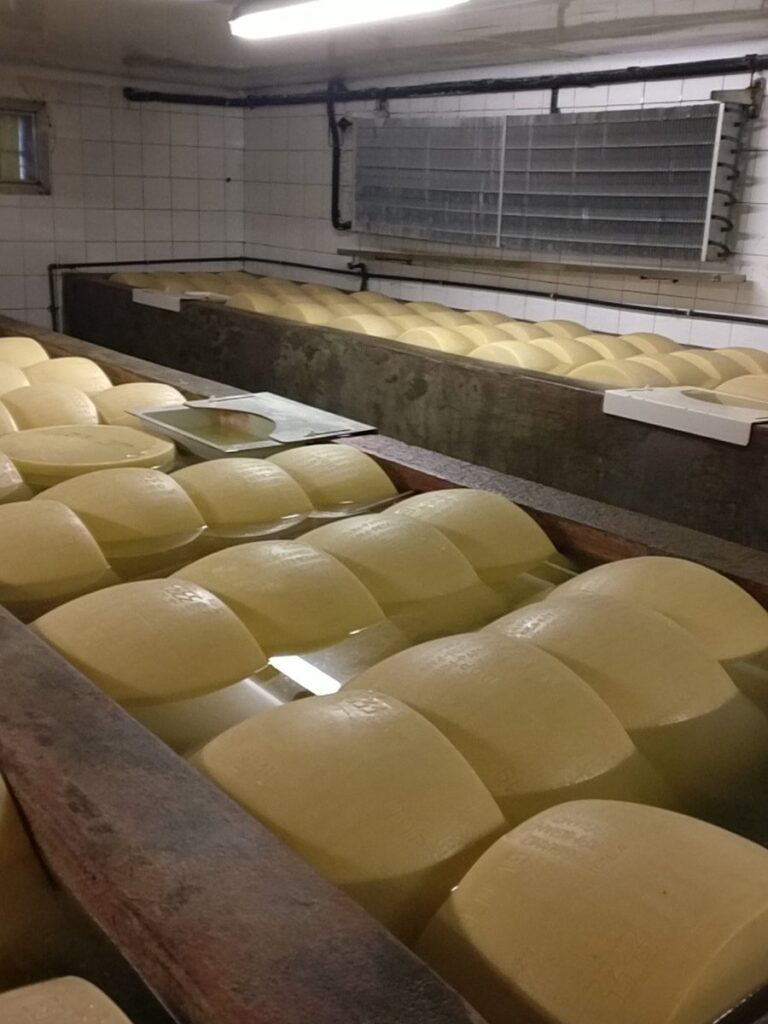
Step 5 – Aging and Consortium inspection
After the brining is complete, the wheels are stored on wooden shelves in temperature-controlled aging rooms, where they stay for a minimum of 12 months up to 40 months. That’s why you will find 12, 18, 24, 36 and 40 months aged Parmigiano Reggiano.
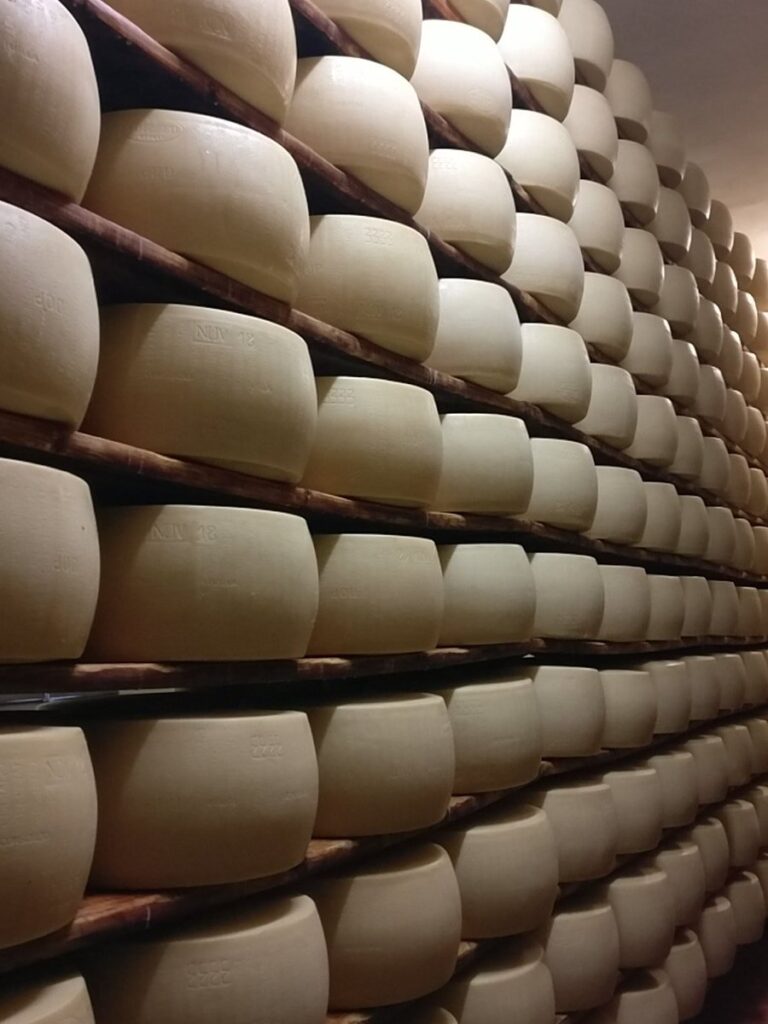
After 12 months of aging, members of the Consortium of Parmigiano Reggiano visit the dairy to inspect the structure of each and every wheel, which they then approve and mark for pristine quality (or not).
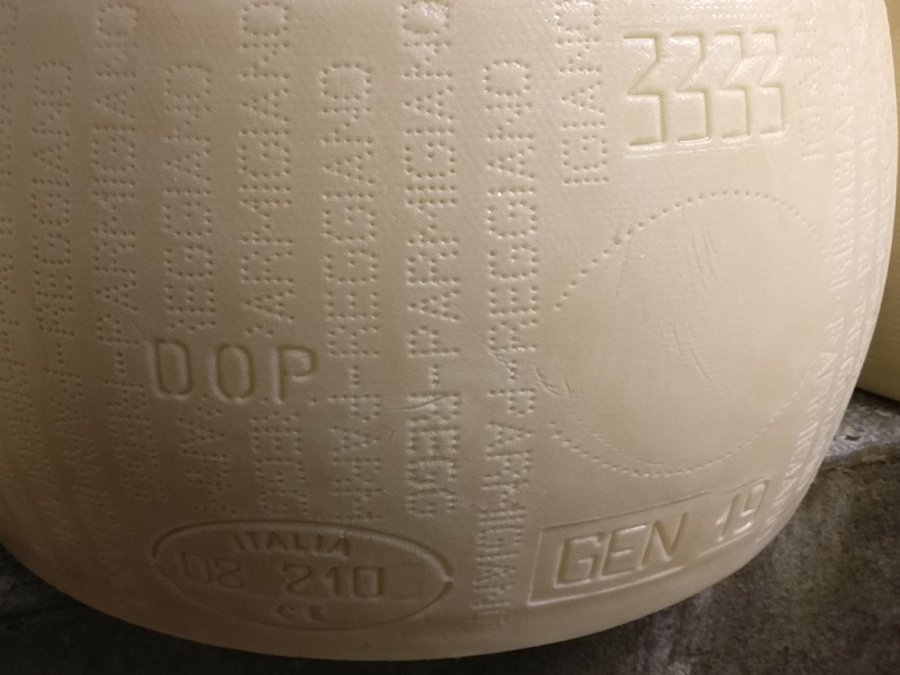
During the aging period, a chemical phenomenon called proteolysis takes place: long-chain proteins in the curd break down into amino acid compounds. These amino acids are responsible for the complex textural and flavor nuances in an individual wheel of cheese: this is why very mature (36 and 40 months) Parmigiano-Reggiano will occasionally have small salty crunchy bits (called tyrosine) throughout as a result.
Are you curious about the differences that aging can give to texture and taste? You can try that, at home, taking advantage of this mix created by a local! 18 months vs 24 months vs 36 months.
The history of Parmigiano Reggiano and the Consortium
Parmigiano Reggiano cheese was born in the Middle Ages, in the monasteries of what today is the Emilia Romagna region. In particular, it is said that the monks of the Benedictine monastery of Corniano, near Bibbiano, are the ones who created the recipe during the XII Century. While the very first mention of the name “Parmigiano Reggiano” backs to the XIII Century, the first famous mention is in the famous Decameron by Boccaccio, one of the Fathers of Italian literature (XIV Century). In the Decameron, there is a place, named Bengodi (since then used in Italian to denote an incredibly rich country), where inhabitants use to throw ravioli and macaroni cooked in capon broth down a mountain of grated Parmigiano Reggiano.
The Parmigiano Reggiano we know and love today is very similar to the one from the Middle Ages. To prevent changes from the recipe and to tackle counterfeiting, during the XX Century the manufacturers in Parma and Reggio Emilia started to collaborate. In 1928 they established what is today the Consortium for Parmigiano Reggiano cheese.
The Consortium issues the Guidelines that rule the Parmigiano Reggiano production and distribution and is the bestower of this Protected Designation of Origin (PDO) status (in Italian, DOP).
Parmigiano Reggiano characteristics and nutrition facts
Color and flavor
As you can easily understand, every wheel is different. This diversity is mainly due to the seasonality, since cheese is made year-round, but also to the sensibility of the cheesemaker.
Color strongly depends on aging and ranges from pale yellow to deep gold.
Parmigiano Reggiano is famous for being one of the few foods that touch the fifth taste (after saltiness, sweetness, sourness and bitterness): umami.
Is Parmigiano Reggiano lactose-free?
Parmigiano Reggiano is naturally lactose-free, since lactose is lost during the making process.
It is highly recommended in almost any diet since it is very rich in Proteins (about 33%), sugar-free (0%), high in Calcium. Only attention point, the Sodium content (8%) is quite relevant.
In Italy is considered the typical food that any doctor recommends to children and teenagers to grow healthy, and plays a central role in the famous Mediterranean diet.
Is Parmigiano Reggiano and Parmesan the same?
Every year, about 3.7 million wheels, each of them bringing a weight of about 40 kgs, are made in the 350 dairy farms that are located in the Parmigiano Reggiano area and follow the Consortium rules. Only those wheels, who have met the PDO requirements, are the authentic Parmigiano Reggiano.
What is Parmesan instead? In Europe, the name can be used only to identify the PDO-compliant Parmigiano Reggiano.
Outside Europe, the term Parmesan is not protected by law, so you will find cheeses labeled “Parmesan” that are Parmigiano Reggiano imitations from the USA, Australia or other countries. That ultimately brings on your tables a different product, with differences in complexity and consistency, since no strict rules have been applied to that cheese.
Believe me, I tried during my trips to the USA a Parmesan cheese… and if you try Parmigiano Reggiano you will never go back! 🙂
Is Parmigiano Reggiano and Grana Padano the same?
Grana Padano is another “grana” cheese, grana meaning grain in Italian. Grana cheese is so-called because of the grainy, crystalline texture they all share.
The compliance framework that rules Grana Padano is less strict than the one regulating Parmigiano Reggiano:
| Parmigiano Reggiano | Grana Padano | |
|---|---|---|
| PDO protection | Yes | Yes |
| Area | Parma, Reggio Emilia, Modena, part of Bologna, part of Mantova (much smaller) | Pianura Padana (much wider, the whole area of Po river) |
| Cows food | From soils very similar. Only grass and cereals grown in the area (no silage allowed) | From soils very diverse. Silage is allowed |
| Milk | Whole milk and skimmed milk | Partially skimmed, 100% |
| Milk freshness | The milk cannot be refrigerated (no temperature below 18 °C). The milk must be delivered to the dairy within 2 hours from milking | The milk can be refrigerated (up to 8 °C). The milk can be delivered to the dairy up to 24 hours from milking |
| Preservatives | Not allowed | Allowed (usually lysozyme) |
| Aging | Slower, due to higher fat content (at least 12 months) | Quicker, due to lower fat content (at least 9 months) |
Ultimately, from the user’s perspective, we can say that Parmigiano Reggiano has a stronger, more complex, nuttier, and saltier taste, while Grana Padano has a softer, subtler taste. That’s why Grana Padano is more usually used in cooking, while Parmesan is more often grated on top of a dish or put at the center of your aperitivo in the form of chunks and paired with prosecco.
Parmigiano Reggiano recipes and pairings
Well, listing all the uses of Parmigiano Reggiano in Italian food is really hard. Anyway, I try 🙂
- as an appetizer: in shards, with honey, jam (figue jam is amazing), balsamic vinegar, fresh fruit (grape or figues). Always remember: never cut with a knife, but break the cheese using the tip of it;
- as a fundamental ingredient of risotto, in the final step (mantecatura): sausage and barbera, pumpkin or fava bean risotto are just some examples you can find in this blog;
- grated, on top of pasta: some recipes perfectly pair with Parmigiano Reggiano, including ragù bolognese or tortellini in brodo (broth), while others definitely not (e.g. simple tomato and basil sauce for spaghetti or fish-based recipes like shrimp and tuna pasta or a sauce with swordfish);
- grated, often together with bechamel sauce, to create incredible baked food, like lasagne bolognesi, pasta al forno or simply gratin vegetables;
- in flakes, for healthy and super tasty salads;
- last but not least, never, I mean, never throw away the rind. It can be used in many ways, to give an umami taste to your recipes. E.g., my mom always put it in the pot while making the broth, I use it to prepare wonderful bean stew or tasty soups.
Parmigiano Reggiano wine pairings
When coming to wine pairings, Parmigiano Reggiano is pure joy. Few foods can be as versatile as the King of cheese: red or white, sparkling or still, it is hard to be wrong.
My favorites:
- white, still: I love white wines from North-Eastern Italy, so I would pick a Collio or Colli Orientali del Friuli from Friuli or a Pinot Grigio from Friuli or Trentino
- red, still: try Amarone or Barolo with Parmigiano Reggiano and you will live an unforgettable experience;
- sparkling: here the perfect pairing comes from the territory of the cheese itself! Let’s go to Emilia Romagna and have a good Lambrusco with Parmigiano Reggiano!
Why is Parmigiano Reggiano so expensive
If you have read so far, I think you have an idea of the reasons behind the high price of Parmigiano Reggiano.
1 kg of Parmigiano Reggiano requires:
- 16 liters of fresh milk, just milked from cows fed with local grass and no added preservatives
- lots of cheesemakers work
- at least 12 months of aging (usually I buy 24 or 36 months old Parmigiano Reggiano).
Hard to find better-spent money 🙂
How to store Parmigiano Reggiano
Parmigiano Reggiano is usually sold vacuum-packed. Until it’s in the original, sealed package, you will keep it in the fridge (4 to 8 °C).
When you buy it freshly cut from the wheel or when you take it out of the vacuum pack, you will keep it in the fridge, in glass or plastic containers, in order to not absorb other foods’ smells.
Another often adopted solution is to wrap it in food-grade plastic film (always in the fridge).
In these ways, you can keep the Parmigiano Reggiano for a long period; just remember to periodically check it, in order to avoid possible mold.
One last thing: never freeze Parmigiano Reggiano
Conclusions
I tried to share with you all I know about Parmigiano Reggiano and my experiences with a cheese that is really IMHO the King of cheese. I hope you appreciate this incredible food as much as I do. If you have additional questions to the many I tried to answer, please leave a comment and I will update the post! Enjoy 🙂

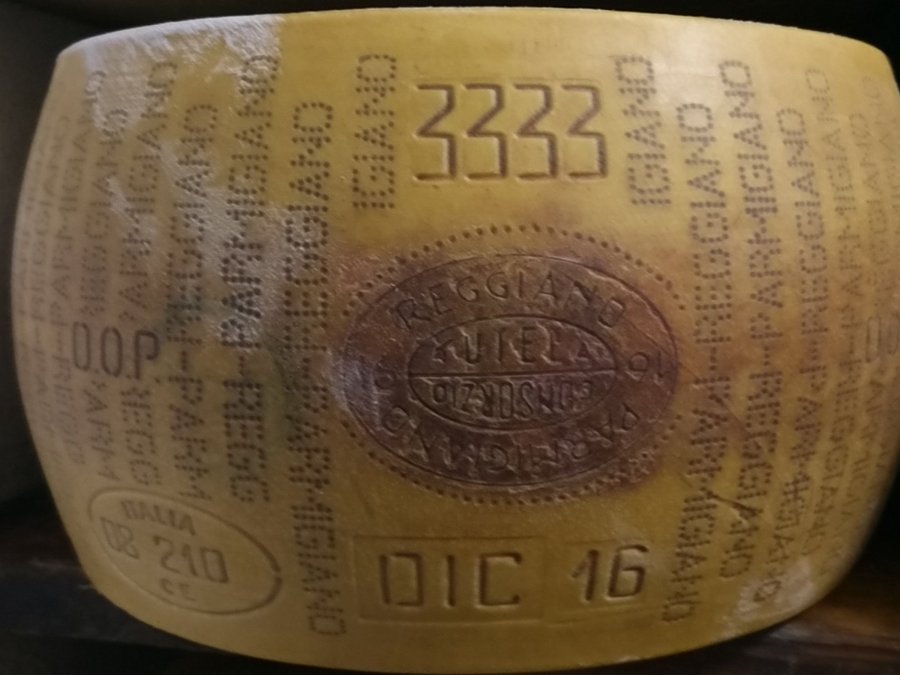
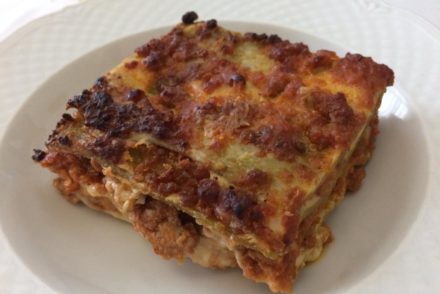
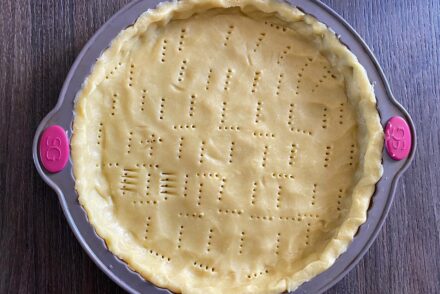
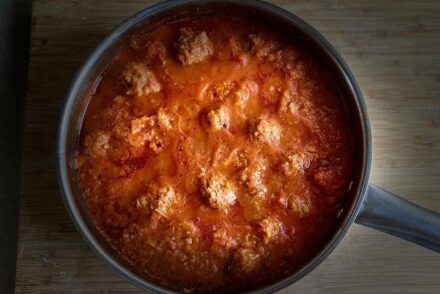
9 Comments
Someone I know says the parmigiano reggiano that is imported to the US is not the same cheese that I would buy in Italy. Is this true?
Thank you
Hi, and thanks for your comment! If the rind has the Parmigiano Reggiano iconic stamp, it should be real. We export a lot to the USA, but yes, unfortunately, the fake one is hugely present. As an example, this one is true: https://amzn.to/38vcUn4
Hope you will enjoy!
Roberto
how do i sign up for your newsletter?
Can’t you see the bar on bottom with the Subscribe button? Hope this helps! Ciao, Roberto
What is the meaning of the number 3333 printed on top of the wheel and the 08 210 at the bottom indicate? Thanks
Hi Lola,
thanks for asking! Any wheel is produced in a dairy, and one code (in this case “3333”) identifies the dairy. Then there is a date (Dic 16), month and year of production. Finally, a code (08 210) identifies the wheel within the diary.
Ciao!
Thank you for your really informative piece on Parmigiano Reggiano. It was fascinating seeing the cheesemakers at work too. I’ve been eating it for years, but didn’t know I shouldn’t slice it with a knife…. as from tomorrow I’ll break it!
I am glad you appreciated! If it happens that you will visit Italy, reserve half a day for a visit, it is worthy!
I am glad you appreciated it! If it happens that you will visit Italy, reserve half a day for a visit, you won’t regret!